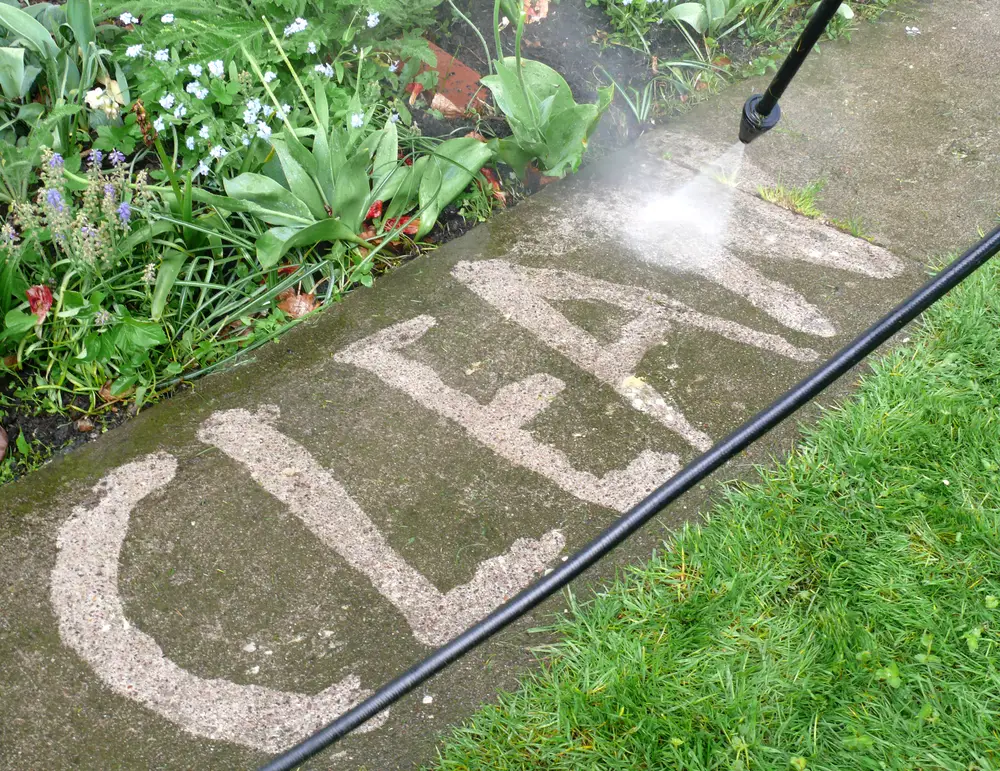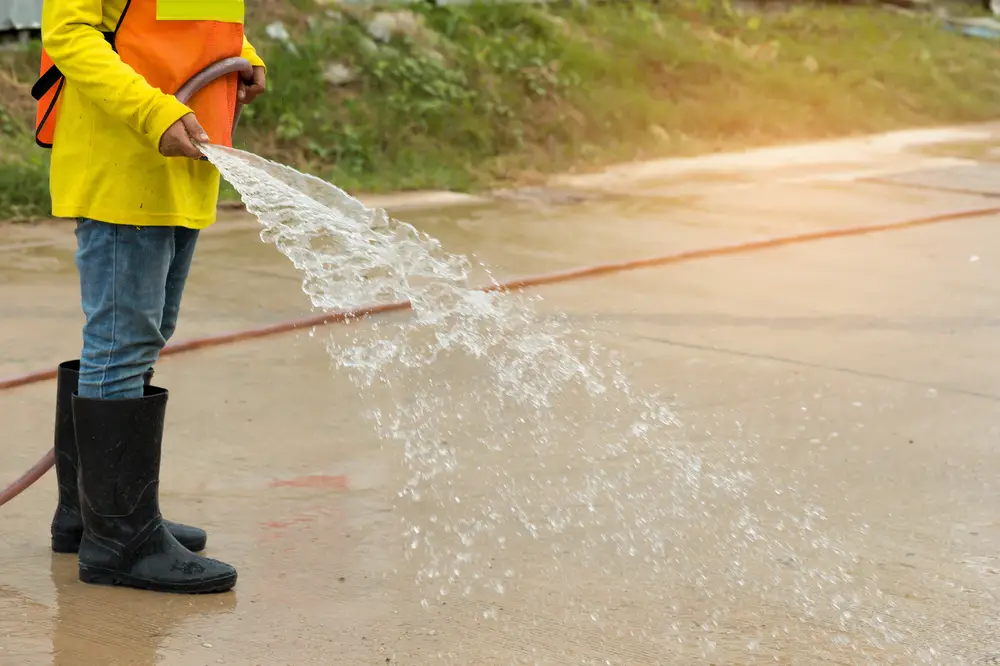Your concrete driveway looked perfect initially, but after a few years, the build-up from dirt, weather from the elements and moss growth have probably left your concrete driveway looking old and a little bit tired or at the very least, significantly more weathered.
Whether you’re trying to clean concrete pavers on a walkway or scrub up your driveway, you’ll want to avoid killing any surrounding vegetation. Most species of grass are fairly fickle and will not take well to absorbing a large amount of toxins that you inadvertently introduce to the ground while cleaning. When we recently cleaned up our backyard, we needed to avoid using chemicals that would destroy the plants around the pavers and found several solutions that would cause minimal damage
Household products like baking soda, dishwashing liquid, and vinegar can clean concrete without killing grass. Using an acidic cleaner will damage the concrete and will require neutralizing afterwards. Powerful acidic solutions will kill plants and are dangerous to humans, so please use precaution whenever considering a heavy duty cleaning agent.
Cleaning a concrete driveway is quite a job, and while you can hire specialist cleaners, it’s also a job you can handle yourself, often using just a few household items. Different cleaners will work better depending on the types of stains and dirt on your concrete. When using various products, you will have to take care – mixing acids and bases like vinegar and baking soda can cause nasty chemical reactions. I’ll go through all the steps you need to take to clean your concrete driveway without killing the grass you have planted around it.
How To Clean A Concrete Driveway Without Killing Grass

If your concrete driveway has been dirtied and discolored by rain, bird droppings, moss, and the general detritus of outdoor dirt, you’ll still be able to get it looking great again – mainly by applying some elbow grease and a few choice household ingredients. Especially if you want to avoid harsh chemicals that will kill your plants or can be dangerous to people and animals, there are a few preparatory steps you’ll need to take first.
Once your concrete is clean, consider applying a sealer to help prevent staining. If you lay new concrete, getting it sealed will keep your concrete looking better for longer, so it’s a good first step.
Cleaning your concrete will probably need to be an annual job, and by using sealant, you’ll make that once-a-year task less overwhelming.
What You Will Need to Clean A Concrete Driveway Without Killing Grass
Before you begin, get together the tools you will need. Most of these are everyday household items or can be purchased reasonably cheaply.
- A stiff-bristle broom, but not a wire-bristled one, as the wires damage the concrete and sealer, and a dustpan.
- Absorbent material for puddles – cat litter or baking soda.
- A bucket for mixing cleaning solutions – ideally, a large bucket for you to dip the brush into the solution.
- Hosepipe to wet down all the concrete.
- If your concrete is heavily stained, you may want to rent or purchase a power washer with adjustable pressure. Keep in in mind, however, using too much pressure on concrete can and will damage the surface. The recommended PSI is between 1800-2300. You can check out this article for a more detailed overview of good pressure washer practices.
- Cleaning products – dishwashing liquid, vinegar, and baking soda.
- Sealer, if you wish to keep your concrete protected.
Steps to Clean Concrete Driveway Without Killing Grass
To avoid runoff from the cleaning products killing any of your plants or grass, it’s best to stick to diluted cleaners that are not highly poisonous. This is why I’ve suggested using only dishwashing liquid, vinegar, and baking soda. These items will work to break down oily stains and penetrate the concrete to lift dirt but they will present only a minimal risk of damage to the surrounding yard.
DO NOT MIX VINEGAR AND BAKING SODA. This is mixing an acid and base, which renders the solution useless for cleaning and can also release toxic fumes. If you have heavily stained areas and you wish to try bleach, remember that bleach should be well-diluted, and you should wear gloves to keep your hands protected.
Step 1 – Sweep The Surface
Clean your concrete driveway thoroughly by sweeping up all the dirt and fallen leaves. If there are patches of the driveway with standing puddles of liquid – be it water or grease – you can use an absorbent material like cat litter or baking soda to absorb it before sweeping up the mess.
Make sure the concrete area is clear before you begin the next stage.
Step 2 – Diluted Cleaning Solution
Dampen your concrete with a garden hose, then mix a solution of 2 Tablespoons dish soap into 3 Gallons of water.
Dip your stiff-bristled broom into the cleaning solution, and brush this across your concrete driveway. Depending on how tough the stains are, some areas may need to be scrubbed more vigorously than others.
There are excellent options available on the market right now for scrub brushes that reduce the amount of elbow grease required. One such versatile option is made by SWOPT.
Step 3 – Hose Your Driveway Clean

Don’t leave the soap to dry as this can leave streaks and white marks. Hose your driveway thoroughly, and try to avoid blasting any surrounding plants.
Give your driveway some time to dry.
Step 4 – Tackle Tough Stains
Once your driveway has dried completely, you’ll be able to see if any areas of tough, ingrained stains remain. You may have to spot-treat these patches with a stronger cleaning solution.
Vinegar is a mild acid that you can use to clean stains, but be aware that acids will also eat into your concrete and will need to be neutralized afterward with a base like baking soda.
If the stained area is small and not near plants, you can leave vinegar to soak on the stain for 20 minutes before scrubbing and rinsing the area. Reclean the section with a baking soda solution afterward.
If you are working near plants, dilute the vinegar with lots of water. A suggested ratio is one part white vinegar to one part water.
Step 5 – Hose Away Residue
Ensure all cleaning products have been removed by hosing your driveway down again. This will also further dilute any detergents, making them less likely to kill grass or plants.
Step 6 – Apply Sealer
Once your newly cleaned concrete driveway has completely dried, you can apply a sealer that will help keep the concrete from being stained and make next year’s clean-up job more manageable. You will need a hand-pump garden sprayer to apply this evenly.
Conclusion
Cleaning your concrete driveway without killing any grass or plants can be done using mild cleaners such as dish soap. Tackle tough stains with vinegar or a baking soda solution, and be sure to thoroughly rinse your driveway clean when you’re done. Applying a concrete sealer is an excellent idea to help protect your concrete from further stains.
Sources
https://homeguides.sfgate.com/clean-concrete-pathway-harming-surrounding-grass-35649.html
https://homesteady.com/clean-concrete-pathway-harming-surrounding-grass-8166.html
https://www.wikihow.com/Make-a-Vinegar-Cleaning-Solution
https://www.quora.com/How-do-you-clean-a-concrete-driveway-without-killing-the-grass
https://www.wolfpaving.com/blog/cleaning-concrete-what-products-should-you-use
